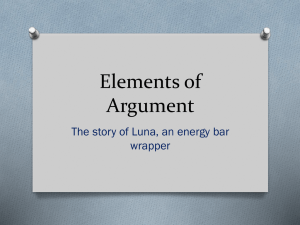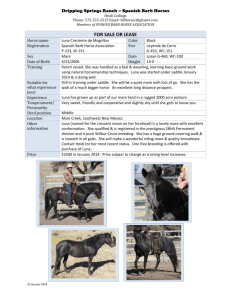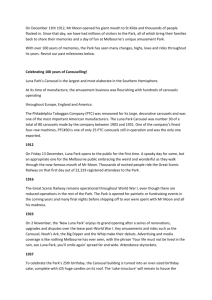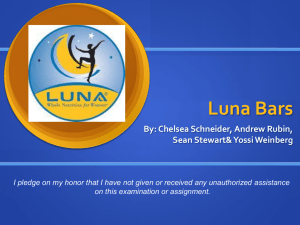Homework 2
advertisement
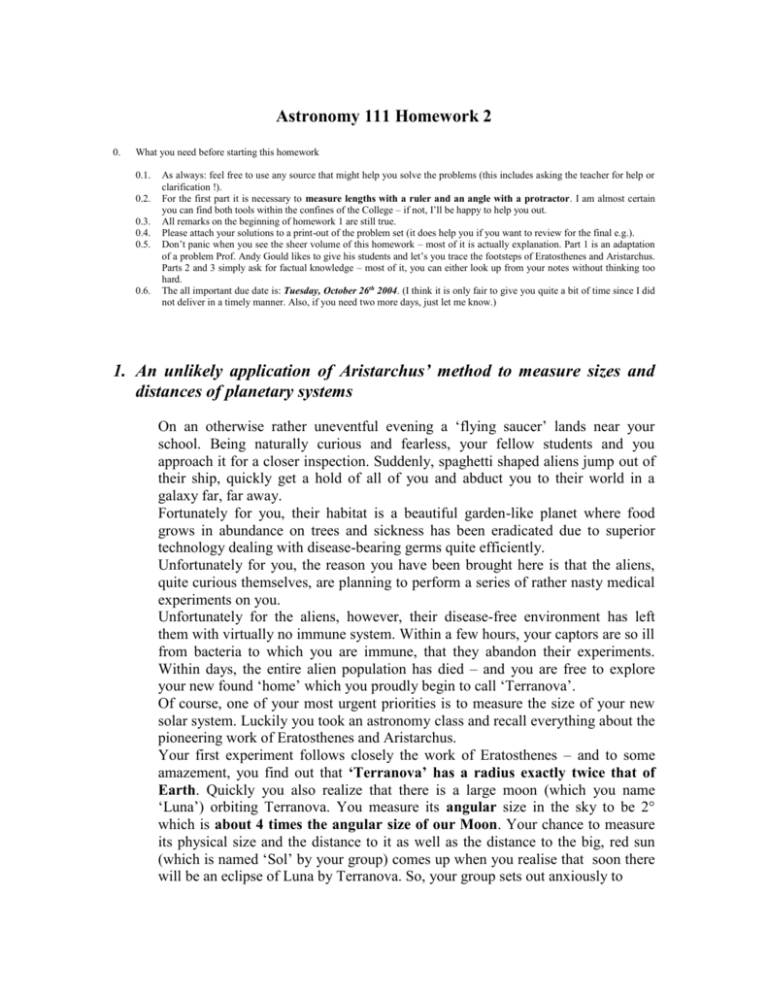
Astronomy 111 Homework 2 0. What you need before starting this homework 0.1. 0.2. 0.3. 0.4. 0.5. 0.6. As always: feel free to use any source that might help you solve the problems (this includes asking the teacher for help or clarification !). For the first part it is necessary to measure lengths with a ruler and an angle with a protractor. I am almost certain you can find both tools within the confines of the College – if not, I’ll be happy to help you out. All remarks on the beginning of homework 1 are still true. Please attach your solutions to a print-out of the problem set (it does help you if you want to review for the final e.g.). Don’t panic when you see the sheer volume of this homework – most of it is actually explanation. Part 1 is an adaptation of a problem Prof. Andy Gould likes to give his students and let’s you trace the footsteps of Eratosthenes and Aristarchus. Parts 2 and 3 simply ask for factual knowledge – most of it, you can either look up from your notes without thinking too hard. The all important due date is: Tuesday, October 26th 2004. (I think it is only fair to give you quite a bit of time since I did not deliver in a timely manner. Also, if you need two more days, just let me know.) 1. An unlikely application of Aristarchus’ method to measure sizes and distances of planetary systems On an otherwise rather uneventful evening a ‘flying saucer’ lands near your school. Being naturally curious and fearless, your fellow students and you approach it for a closer inspection. Suddenly, spaghetti shaped aliens jump out of their ship, quickly get a hold of all of you and abduct you to their world in a galaxy far, far away. Fortunately for you, their habitat is a beautiful garden-like planet where food grows in abundance on trees and sickness has been eradicated due to superior technology dealing with disease-bearing germs quite efficiently. Unfortunately for you, the reason you have been brought here is that the aliens, quite curious themselves, are planning to perform a series of rather nasty medical experiments on you. Unfortunately for the aliens, however, their disease-free environment has left them with virtually no immune system. Within a few hours, your captors are so ill from bacteria to which you are immune, that they abandon their experiments. Within days, the entire alien population has died – and you are free to explore your new found ‘home’ which you proudly begin to call ‘Terranova’. Of course, one of your most urgent priorities is to measure the size of your new solar system. Luckily you took an astronomy class and recall everything about the pioneering work of Eratosthenes and Aristarchus. Your first experiment follows closely the work of Eratosthenes – and to some amazement, you find out that ‘Terranova’ has a radius exactly twice that of Earth. Quickly you also realize that there is a large moon (which you name ‘Luna’) orbiting Terranova. You measure its angular size in the sky to be 2° which is about 4 times the angular size of our Moon. Your chance to measure its physical size and the distance to it as well as the distance to the big, red sun (which is named ‘Sol’ by your group) comes up when you realise that soon there will be an eclipse of Luna by Terranova. So, your group sets out anxiously to 1. Determine the physical size of Luna a. You observe the eclipse of Luna and draw an accurate plot of the situation at one certain point of time during the event (see Figure 1). Here the outermost circle represents the edge of Luna, the inner circle is totally black because it represents the part of Luna that is totally eclipsed by Terranova and the middle circle is grey because it is the region partially eclipsed by Terranova. Of course, you took great care to have all the sizes to scale. Take a ruler and measures the diameters of all three circles and record your results. b. You faintly remember from the work of Aristarchus of Samos that the projected diameter of the eclipsing body is equal to the average of the diameters of the totally and partially eclipsed regions. 1 Find this average from your results in a. and record it. c. What is bigger: the circle representing Luna or the circle with a diameter of the average you just calculated? d. What is the ratio of the diameters of Luna and Terranova? (That is, write DL/DT = ? where DL = diameter of Luna and DT = diameter of Terranova as measured in a.) Does it matter for this ratio whether you did not use the actual physical diameters of both objects, but just the values from your drawing? 2. Determine the distance to Luna a. How much further away is Luna from Terranova than our Moon from the Earth? This is actually much simpler to determine than you might fear: How much bigger is Terranova’s diameter than Earth’s? Next, how big is Luna compared to the Earth? Then, how much bigger than the Moon is Luna physically?2 Finally, how much bigger does Luna appear in the sky than the Moon ? So, what does that mean for its distance compared to the Moon’s distance to Earth? Following these simple steps, you find out how far away Luna is from Terranova. b. Be sure to list your result both in the physical unit3 (km) as well as a ratio of the distance Moon-Earth compared to distance Luna-Terranova). 3. Determine the distance to Sol a. You remember that you can also measure the distance to Sol by an observation of the half illuminated Luna. Just like Aristarchus you determine the angle between a half-Luna and Sol (cf. Figure 2). In that figure, please mark where there is the right angle and measure the angle between Sol and Luna. Note: We have not covered this specific theorem in class – so if you have any questions about it, feel free to ask. It is, essentially, again some basic geometry – remember: the Greeks were intoxicated by it! 2 Here you will actually have to look that up somewhere in a table in your book. 3 Also look up the distance Moon-Earth somewhere. 1 b. Measure the distances from Terranova to Luna as well as to Sol. How much further away is Sol than Luna? Does your result depend on the fact that you measured this from a drawing instead of the ‘real’, physical distances? c. How far is Sol from Terranova in units of km? d. How far is Sol from Terranova in units of distance from Earth to our Sun?4 Congratulations: you have correctly determined the size of the new world you have to live in. Do you think this is a very realistic solar system? 2. On the concept of Geocentric and Heliocentric Systems a. The motion of which objects was so hard to explain for ancient astronomers? Describe that motion as precisely as possible. What specifically was so confusing about it? b. Can you describe the motion of the Sun, the Moon, the stars and the planets from a geocentric point of view? c. What is an epicycle, a deferent and an equant and why were they introduced to the models of the solar system of Ptolemy? (A sketch might help.) d. What was Copernicus idea with respect to the model of our Solar System? Was this a new idea? Was his model significantly better (i.e. more precise) in describing the solar system? What was his problem? e. How did Kepler finally solve the puzzle of describing the motion of the planets that had haunted scientist for more than 2000 years? What was Brahe’s contribution? Briefly describe Kepler’s Three Laws, please. f. What big advantage did Galileo have over his predecessors? Describe the four key observations that he made that led to the downfall of the geocentric system? Please give a short explanation what made them incongruent with this system. g. Why is Newton’s approach to the motion of the planets so superior to all his predecessor’s efforts? Do all objects have to orbit on ellipses? 3. Newtonian Laws and Gravity a. What is the natural state of bodies? What causes motion? b. What is the difference between speed and velocity? c. “The mass of the Sun is much bigger than the mass of Earth. Thus, the gravitational force on the Earth is much bigger than the force on the Sun – and therefore it is the Earth moving around the Sun.” What is wrong with this statement? d. The moon is basically free-falling around the Earth. Why does it not fall down unto Earth just like an apple? e. Along the same lines: What is the difference between ‘zero gravity’ and ‘weightlessness’? 4 This is usually called one Astronomical Unit and can be looked up again. Figure 1 : The Sketch of Luna’s Eclipse Edge of Luna Partial Eclipse Coverage Total Eclipse Coverage Luna Sol Terranova Figure 2 : Drawing of ‘Half-Luna’, Sol and Terranova Note : Angles are accurate, sizes of the objects are NOT to scale.
